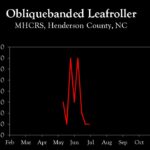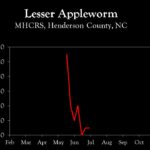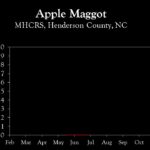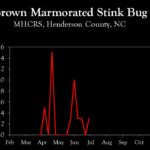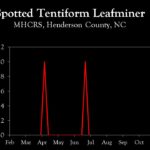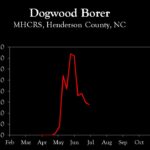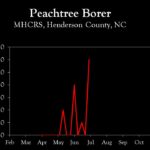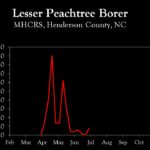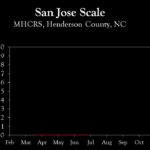WNC Orchard Insect Pest Populations – July 3, 2023
go.ncsu.edu/readext?944169
en Español / em Português
El inglés es el idioma de control de esta página. En la medida en que haya algún conflicto entre la traducción al inglés y la traducción, el inglés prevalece.
Al hacer clic en el enlace de traducción se activa un servicio de traducción gratuito para convertir la página al español. Al igual que con cualquier traducción por Internet, la conversión no es sensible al contexto y puede que no traduzca el texto en su significado original. NC State Extension no garantiza la exactitud del texto traducido. Por favor, tenga en cuenta que algunas aplicaciones y/o servicios pueden no funcionar como se espera cuando se traducen.
Português
Inglês é o idioma de controle desta página. Na medida que haja algum conflito entre o texto original em Inglês e a tradução, o Inglês prevalece.
Ao clicar no link de tradução, um serviço gratuito de tradução será ativado para converter a página para o Português. Como em qualquer tradução pela internet, a conversão não é sensivel ao contexto e pode não ocorrer a tradução para o significado orginal. O serviço de Extensão da Carolina do Norte (NC State Extension) não garante a exatidão do texto traduzido. Por favor, observe que algumas funções ou serviços podem não funcionar como esperado após a tradução.
English
English is the controlling language of this page. To the extent there is any conflict between the English text and the translation, English controls.
Clicking on the translation link activates a free translation service to convert the page to Spanish. As with any Internet translation, the conversion is not context-sensitive and may not translate the text to its original meaning. NC State Extension does not guarantee the accuracy of the translated text. Please note that some applications and/or services may not function as expected when translated.
Collapse ▲ In lower elevation orchards (e.g., Cleveland County and nearby locations), second generation codling moth is at about 12% egg hatch. This coincides with timing of insecticide applications in orchards with low populations and/or very little damage from the first generation. Hence, an insecticide targeting this generation should be considered this week if one has not been recently applied. In those orchards using mating disruption, it is highly unlikely that insecticides are necessary against codling moth.
In lower elevation orchards (e.g., Cleveland County and nearby locations), second generation codling moth is at about 12% egg hatch. This coincides with timing of insecticide applications in orchards with low populations and/or very little damage from the first generation. Hence, an insecticide targeting this generation should be considered this week if one has not been recently applied. In those orchards using mating disruption, it is highly unlikely that insecticides are necessary against codling moth.
In higher elevations, such as Henderson County, second generation adults are just beginning to emerge. Based on the forecast, the optimum timing is predicted for about 10-14 days. Again, it is highly unlikely that insecticidal control will be necessary in orchards using mating disruption, but moth capture in pheromone traps should be used as a tool to make this decision.
Resistance Management: When choosing an insecticide to apply for second generation codling moth, it is important to use a product with a different mode of action than was used during the first generation. The two major classes of insecticides recommended for codling moth are the diamides (Altacor, Exirel, and Verdepryn) and spinosyns (Delegate). Hence, if one of the diamides was used against the first generation, Delegate should be targeted for the second generation. Conversely, if Delegate was used for first generation control, one the diamides should be considered against the second generation. It should be noted that all of these insecticides are also highly effective against oriental fruit moth, the third generation of which is just beginning to emerge in lower elevation orchards.
European red mites continue to be a challenge for many growers, even in some orchards where preventive control was applied earlier in the season. In orchards with relatively high populations, Acramite provides the best knockdown activity. Other products that provide good activity against moderate populations densities (e.g., <10 mites/leaf) include Portal, Nexter, Kanemite and Nealta.
Learn more about southeastern apple insect pests at the Apple Insect Management page.
2023 Average Weekly Trap Captures
| HENDERSON COUNTY | |||
| Insects per trap | |||
| June 19 | June 26 | July 3 | |
| Codling moth | 0.5 | 0.0 | 0.5 |
| Oriental fruit moth | 17.5 | 15.0 | 16.0 |
| Tufted apple bud moth | 1.0 | 1.0 | 0.0 |
| Redbanded leafroller | 0.0 | 2.0 | 0.0 |
| Obliquebanded leafroller | 2.0 | 1.0 | 1.0 |
| Lesser appleworm | 0.0 | 1.0 | 1.0 |
| Apple maggot (abandoned and research orchards) | 0.0 | 0.0 | 0.0 |
| Brown marmorated stink bug (commercial) | – | – | – |
| Brown marmorated stink bug (unsprayed) | 0.3 | 0.0 | 0.3 |
| Spotted tentiform leafminer | 0.0 | 1.0 | 1.0 |
| Dogwood borer | 19.0 | 15.0 | 14.0 |
| Peachtree borer | 2.0 | 0.0 | 12.0 |
| Lesser peachtree borer | 1.0 | 0.0 | 4.0 |
| San Jose scale | 0.0 | 0.0 | 0.0 |
*Note that these averages illustrate only the timing of insect emergence and fluctuations in populations, and are not representative of population levels in any given orchard. The only way to have an accurate assessment of an individual orchard’s populations is to set up traps in that orchard.
2023 Accumulated Degree Days
| HENDERSON COUNTY | ||||
| June 19 | June 26 | July 3 | ||
| Codling moth (Biofix: April 7) | 829 | 948 | 1107 | |
| Oriental fruit moth (Biofix: March 24) | 1323 | 1478 | 1672 | |
| Tufted apple bud moth (Biofix: April 21) | 970 | 1124 | 1318 | |







